Diptera.info :: Family forums :: Syrphidae
Who is here? 1 guest(s)
Page 1 of 2: 12
|
|
Brachyopa: more ID possible? --> Brachyopa panzeri
|
|
| kuv |
Posted on 09-05-2015 09:03
|
|
Member Location: Schenefeld near Hamburg Posts: 3793 Joined: 30.04.10 |
Northern Germany, Schleswig-Holstein, Schenefeld near Hamburg, at an uncultivated natural area near a small rivulet, 25 m, Outsidefoto: kuv, 8th of May 2015. Perhaps Brachyopa dorsata? Please help. Kuv kuv attached the following image: 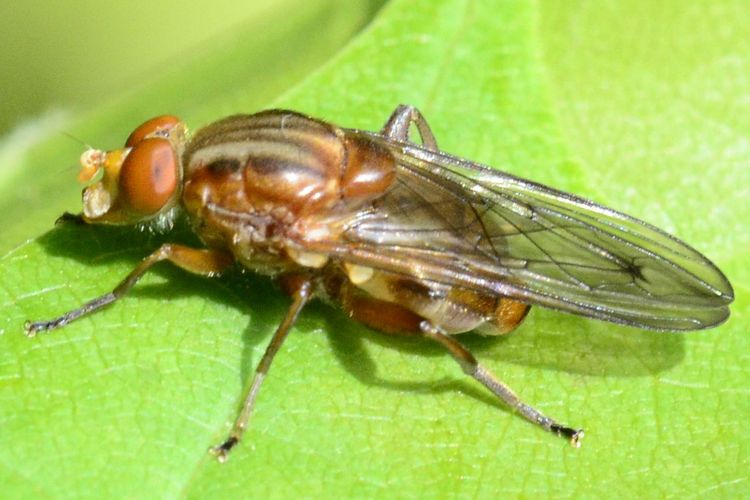 [98Kb] Edited by kuv on 26-11-2019 10:30 |
|
|
|
| kuv |
Posted on 09-05-2015 09:07
|
|
Member Location: Schenefeld near Hamburg Posts: 3793 Joined: 30.04.10 |
2nd pic:
kuv attached the following image: 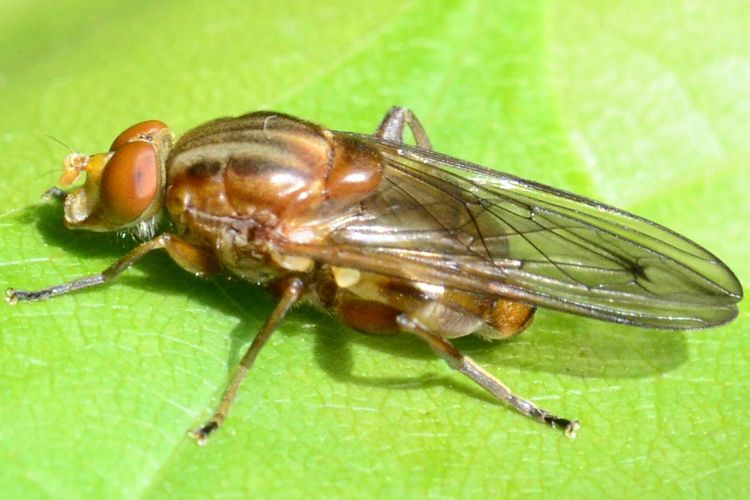 [95.38Kb] |
|
|
|
| kuv |
Posted on 09-05-2015 09:08
|
|
Member Location: Schenefeld near Hamburg Posts: 3793 Joined: 30.04.10 |
3rd pic:
kuv attached the following image: 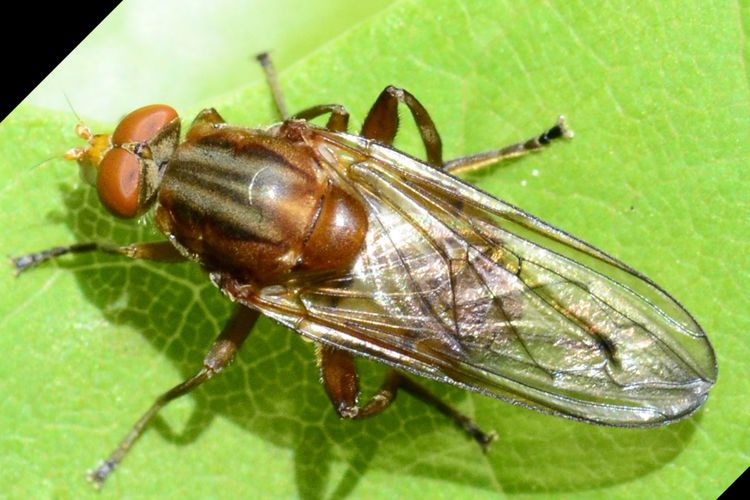 [110.64Kb] |
|
|
|
| kuv |
Posted on 14-11-2019 18:43
|
|
Member Location: Schenefeld near Hamburg Posts: 3793 Joined: 30.04.10 |
Please also here: One more chance to ID. Greetings Kuv |
|
|
|
| johnes81 |
Posted on 23-11-2019 12:16
|
|
Member Location: Berlin, Germany Posts: 1980 Joined: 15.10.16 |
Hello kuv, it should be Brachyopa panzeri due to lack of bristles on scutellum but i don't know if this feature is useful for id or not. see a recent post with similarity: https://diptera.info/forum/viewthread.php?thread_id=92897 Best wishes, John John and Nini. Naturalists not experts. |
|
|
|
| kuv |
Posted on 24-11-2019 11:55
|
|
Member Location: Schenefeld near Hamburg Posts: 3793 Joined: 30.04.10 |
Hi John, thank you very much  that you point me to B. panzeri. I think you are right, as I now found the following charakteristic features of these flies: Antenna not plumose, thorascic dorsum reddish-brown, and segment 3 of the antenna with a pit close to the margin (the last feature is at the pictures of "my" fly not very clear). that you point me to B. panzeri. I think you are right, as I now found the following charakteristic features of these flies: Antenna not plumose, thorascic dorsum reddish-brown, and segment 3 of the antenna with a pit close to the margin (the last feature is at the pictures of "my" fly not very clear).Greetings Kuv |
|
|
|
| Ectemnius |
Posted on 24-11-2019 12:25
|
|
Member Location: The Netherlands Posts: 865 Joined: 22.11.11 |
Hello Kuv & John, I would not identify the species from these photo's. Also in this post: https://diptera.i...ost_385532 I've taken the Dutch material of both species in my collection and compared them. Based on the male specimens and their terminalia I can accurately pinpoint the correct species. The only reliable external feature is the size of the sensory pit on the third antenna segment. Both species have scutellar bristles. Those of B. panzeri are paler than those of B. dorsata. But the bristles can be very short and from these photo's very difficult to see. I'd say B. dorsata/panzeri, in both posts. Kind regards, Ectemnius |
|
|
|
| kuv |
Posted on 24-11-2019 13:18
|
|
Member Location: Schenefeld near Hamburg Posts: 3793 Joined: 30.04.10 |
Ok and thank you Ectemnius  . .I''l change headline. Greetings Kuv |
|
|
|
| johnes81 |
Posted on 24-11-2019 17:11
|
|
Member Location: Berlin, Germany Posts: 1980 Joined: 15.10.16 |
Hello kuv and Ectemenius, I don't have a specimen. I'm judging the scutellum based upon the following document (and i think that the 3rd photo is sharp enough to judge black bristles): https://assets.ar...000332.pdf I'm certainly not an expert and i have little experience with Brachyopa (I currently only have B. bicolor). Thank you for posting, Ectemenius. Best wishes  , ,John John and Nini. Naturalists not experts. |
|
|
|
| kuv |
Posted on 25-11-2019 12:05
|
|
Member Location: Schenefeld near Hamburg Posts: 3793 Joined: 30.04.10 |
Hi John and Ectemnius, first thank you John  for your information. To have a "last chance" of ID I put an enlargement of the part of scutellum, hoping, Ectemnius for your information. To have a "last chance" of ID I put an enlargement of the part of scutellum, hoping, Ectemnius  , to get a statement (although I have no better picture of the antennas). , to get a statement (although I have no better picture of the antennas).Greetings Kuv kuv attached the following image: 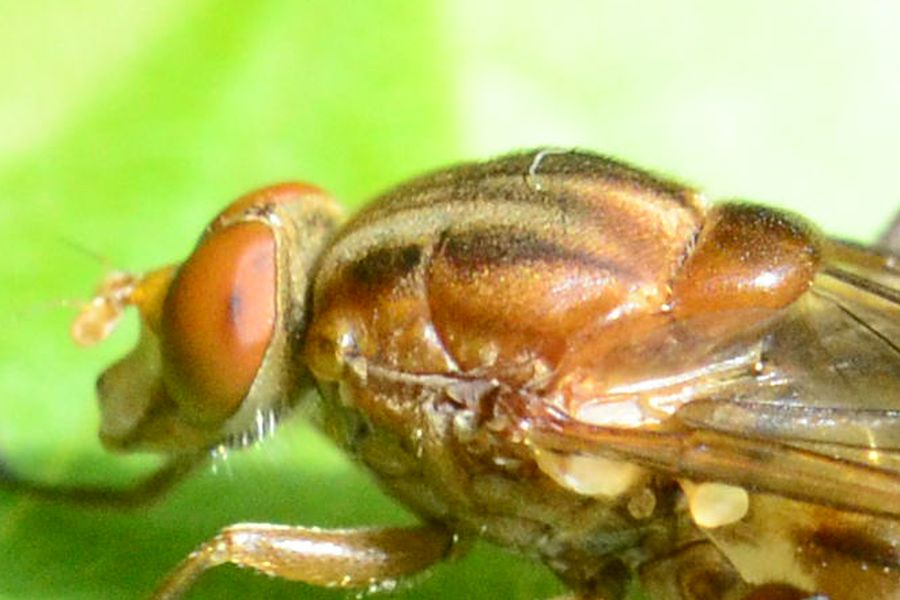 [64.46Kb] Edited by kuv on 25-11-2019 12:08 |
|
|
|
| kuv |
Posted on 25-11-2019 12:09
|
|
Member Location: Schenefeld near Hamburg Posts: 3793 Joined: 30.04.10 |
2nd enlargement:
kuv attached the following image: 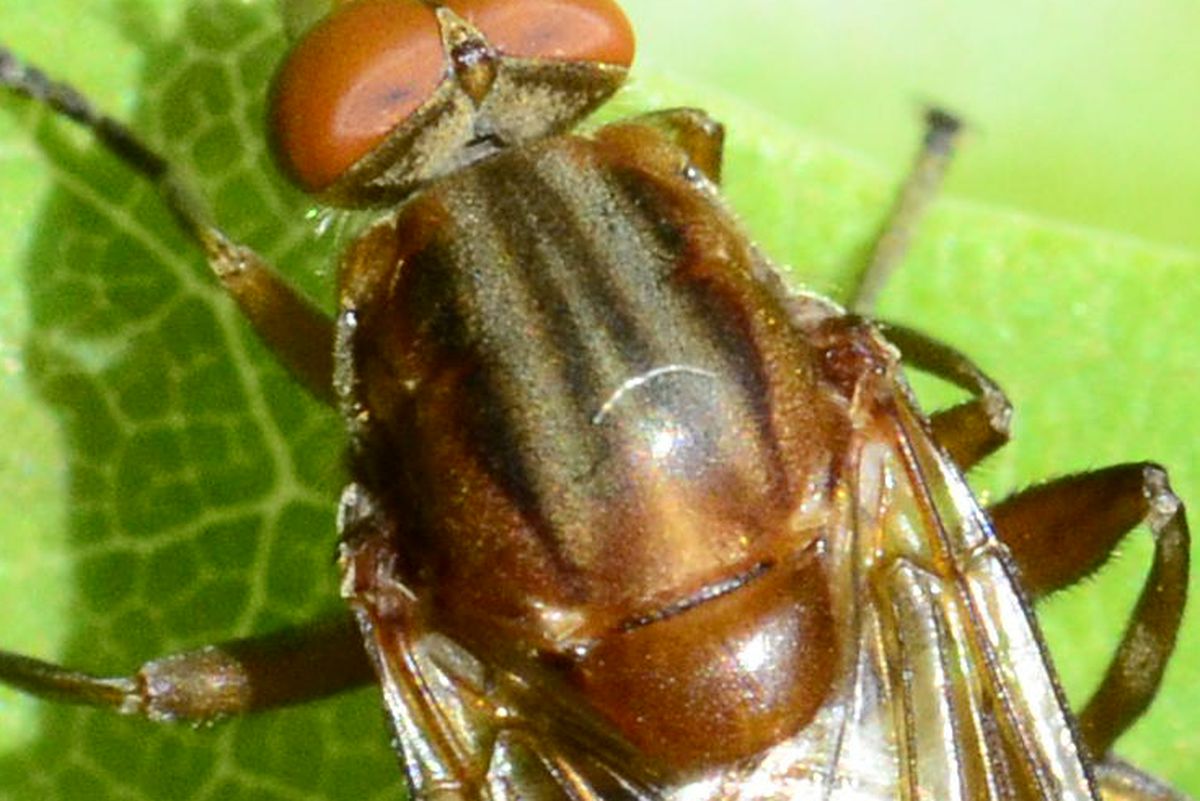 [124.1Kb] |
|
|
|
| johnes81 |
Posted on 25-11-2019 12:39
|
|
Member Location: Berlin, Germany Posts: 1980 Joined: 15.10.16 |
Hello kuv, I mentioned before that i don't know if the black hairs on the scutellum is a reliable feature or not. I don' have a specimen. However, i considered other features along with the scutellum when i suggested B. panzeri. To quote one of my recent posts: "My determination is based upon the many notes/descriptions that i've read. The most recent document that i've studied is authored by Dr. Merz of Switzerland. The document is written in French but it can be translated using Google translate: https://www.unige.ch/sphn/Publications/A…2_Merz_62_2.pdf "In addition, the wings of B. panzeri are often variably browned at the edge and on the vena spuria (midrib of the wing that fades in the middle of the R5 cell) (Fig. 4), but the wings are completely transparent at B. dorsata. This latter character is only found in recent descriptions (from Speight 2008) despite the accompanying drawing of Panzer's description (1798) which clearly shows the partially dark wings." The darkened wings diagnosis is not contested by Dr. Merz. And clearly the vena spuria and the edges of the wings are darkened on the species in your photos. I think that B. panzeri is a better match. See another photo of B. panzeri with darkened wings at spessart website: http://www.spessart-fliegen.de/diptera/s…zeri/1/habd.JPG Jürgen Peters has photos of a Brachyopa sp that fits well with the description of Brachyopa dorsata: Gute Nacht-Schwebfliege vom 24.04.10 -->Brachyopa dorsata/panzeri Please review the photos from Jürgen. Notice that the vena spuria is not darkened and the wing edges are clear/hyaline." I find that the species is a good match for B. panzeri but i am not an expert and i do not yet have a specimen. another quote from one of my posts: "I hope to find both B. dorsata and B. panzeri to study these features and fortify the descriptions with genitalia." Best wishes, John John and Nini. Naturalists not experts. |
|
|
|
| johnes81 |
Posted on 25-11-2019 13:44
|
|
Member Location: Berlin, Germany Posts: 1980 Joined: 15.10.16 |
Hello kuv, I based the id of your photos from the other post, as i do believe that they are of the same species. I did not carefully examine your photos. I usually require reading glasses because my vision is slipping. However, i can clearly see a large pit on the inside of the antennae, which confirms B. panzeri according to various keys. The pit is much smaller on B. dorsata. Microscopic examination is not necessary due to the large visible pit. see my attached crop of your photo with this diagnostic pit. Also see a magnified pit at spessart website: http://www.spessart-fliegen.de/diptera/syrphidae/brachyopa/brachyopa_panzeri/IMG_2443.html I do not place ego before science but it doesn't mean that i am absolutely correct. I think that this is Brachyopa panzeri. I also think that the species in the other photos is also B. panzeri: https://diptera.info/forum/viewthread.php?thread_id=92897&pid=385532#post_385532 Best Wishes, John ps: see figures 4 and six in the following document. https://pdfs.semanticscholar.org/9234/1e5f32fa145698452ee9f8368fbec9e3b52f.pdf johnes81 attached the following image:  [49.71Kb] Edited by johnes81 on 25-11-2019 14:01 John and Nini. Naturalists not experts. |
|
|
|
| johnes81 |
Posted on 25-11-2019 14:47
|
|
Member Location: Berlin, Germany Posts: 1980 Joined: 15.10.16 |
Hello kuv, before i rest my case, i want to cross examine the size of the pit so that the size becomes relevant sans microscopic examination. I may have discovered yet another weak scientific encryption and cracked it. Or it is a coincidence (as protectionist conspiracy theories are concerned.) Do notice that the numbers of the figures are four and six. In order to judge size differences, one must figure out a method to prove the size based on a photo of the pit. In doing so, my first thought is to see how many times the pit will fit inside of the antennae. When i test this method, the amount, surprisingly, is four times for panzeri and six times for dorsata. According to the drawings from experts of Brachyopa. When i test this measurement using your photo, i arrive at four times. Thus, it fits with B. panzeri. The pit on the photo at spessart also fits into the antenna four times. The pit in jarjar's photos (Christoph) also fits four times. I think that B. panzeri is a fine id based upon all of this data. I will attach images to illustrate this concept. Best wishes, John johnes81 attached the following image: 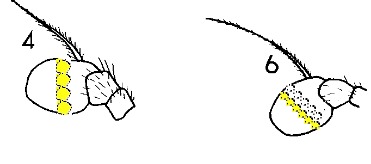 [12.49Kb] John and Nini. Naturalists not experts. |
|
|
|
| johnes81 |
Posted on 25-11-2019 14:49
|
|
Member Location: Berlin, Germany Posts: 1980 Joined: 15.10.16 |
kuv's photo: pit fits four times
johnes81 attached the following image: 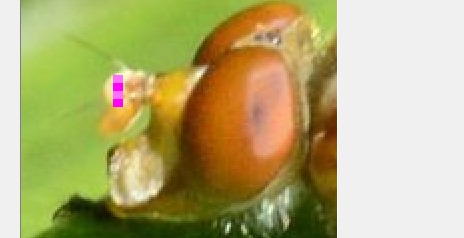 [19.46Kb] John and Nini. Naturalists not experts. |
|
|
|
| Xylosoma |
Posted on 25-11-2019 16:19
|
|
Member Location: Posts: 43 Joined: 14.10.19 |
Characters on pictures support all B. panzer. From Schleswig-Holstein hundreds of specimens of this species are recorded, mostly bred from fresh stumps of Fagus and Acer (same habitat as Merz reported in his paper) while there is only a single, doubtful record of B. dorsata. B. panzer is generally associated with deciduous forests as it seems to be typical for the Schenefeld area while B. dorsata is living in coniferous forest. General distribution and habitat are speaking as well for B. panzer. Xylo. |
|
|
|
| kuv |
Posted on 25-11-2019 16:29
|
|
Member Location: Schenefeld near Hamburg Posts: 3793 Joined: 30.04.10 |
Wooooooooooooooooooooooooooooooooooooooooooooow John  – I'm impressed to your work in helping me to find the right ID. Thank you very much! Now I have to study these new informations ... Note: Of course all of my pictures in this thread are from the same fly. – I'm impressed to your work in helping me to find the right ID. Thank you very much! Now I have to study these new informations ... Note: Of course all of my pictures in this thread are from the same fly.Greetings Kuv I just see, that Xylo supports John's ID: Thank you very much Xylo  Best regards Kuv |
|
|
|
| kuv |
Posted on 26-11-2019 10:29
|
|
Member Location: Schenefeld near Hamburg Posts: 3793 Joined: 30.04.10 |
Hello John, Xylo and Ectemnius, once more thanks to all of you. After reading and checking John's (and Xylo's) arguments I think it must be B. panzeri. John  , it's a very nice work! , it's a very nice work!Greetings Kuv |
|
|
|
| johnes81 |
Posted on 26-11-2019 12:25
|
|
Member Location: Berlin, Germany Posts: 1980 Joined: 15.10.16 |
Hello kuv, All is good. I'm happy that you have an id. I like Brachyopa. I find them to be most interesting from this family (Syrphidae.) Anyway, i did some more research on the black bristles of the scutellum and i discovered that Speight uses this feature in his keys to Brachyopa: https://diptera.info/downloads/StN_KEYS_Glasgow_2011.pdf So it is a valid method of identification. Speight is a leading expert of Syphidae as far as i know. My first post should have ended the conversation. Thank you Xylo. Thank you Ectemenius. Best wishes, John John and Nini. Naturalists not experts. |
|
|
|
| Ectemnius |
Posted on 26-11-2019 17:36
|
|
Member Location: The Netherlands Posts: 865 Joined: 22.11.11 |
Hello people, Hopfully this is not taken as being inconsiderate. But experience has taught me that photo-id like this one can be too optimistic. I've had the experience of being painfully wrong. Having said that, I will publish a Therevidae new for the Netherlands based on a photograph in the coming month... @Xylosoma, I would not identify the specimen based on habitat. In the Netherlands B. panzeri is more typical of mixed and coniferous woods and B. dorsata more common than B. panzeri and typical of deciduous woods... Btw, do you have a reference for that Merz paper. Or even better could you send a .pdf? @John, that is (again) some very impressive detective work! It is certainly new to me that not the presence of bristles, but the colour is seen as diagnostic. And as to your comment: "My first post should have ended the conversation." Hopefully not, as I think we've learned quite a lot. And I'd enjoy that we respectfully disagree, converse and learn from each other in the future... Kind regards, Ectemnius |
|
|
|
Page 1 of 2: 12
| Jump to Forum: |












